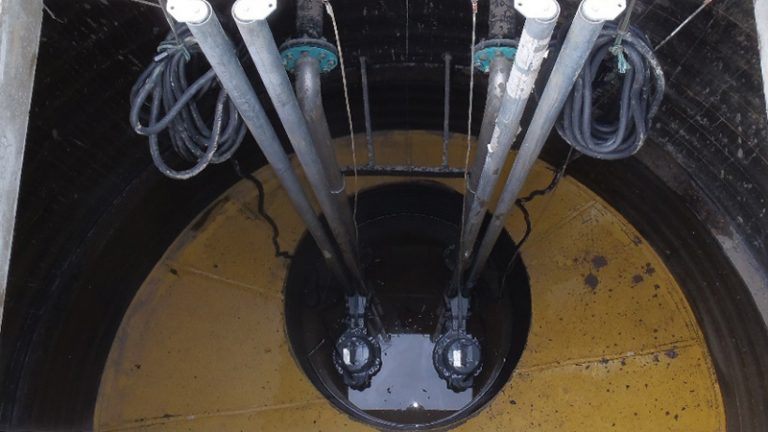Sotshole (Heage) Sewage Pumping Station (2016)

(left) Sheet piling as temporary works and (right) sheet piling and hydraulic walers - Courtesy of NMCNomenca (now Galliford Try)
Severn Trent Water’s (STW) Sotshole Sewage Pumping Station is situated between the village of Heage and the town of Belper, Derbyshire. The existing pumping station serves approximately 330 individuals from the surrounding residential area and is comprised of a wet and dry well topped by a brick superstructure. The emergency overflow chamber is located within the small compound and comprises of a separate storm well with an overflow to the nearby watercourse. The existing pump station offered less than the 2 hours storage at 3 x dry weather flow (as stipulated by Severn Trent Water’s standards) and when pump failure occurred, the surcharging system resulted in pollution incidents to the nearby watercourse.

(left) Finished excavation and (right) Delivery of wet well – Courtesy of NMCNomenca
Project overview
The Heage, Sotshole scheme comprises an on-line replacement and refurbishment of an ageing Sewage Pumping Station (SPS). The site’s restricted location coupled with a 20% efficiency demand, led design and build contractor NMCNomenca (now Galliford Try) to innovatively design an entirely prefabricated solution.
The combination of diligent project procurement and planning saw a pioneering final assembly and installation period of only 11 days. Off-site manufacture and a studious design phase ensured reduced health and safety risks and improved environmental credentials over the construction and future operation of this asset thus delivering STW a highly successful end product.

Wet well lifting operation- Courtesy of NMCNomenca
Drivers and problems
- Inadequate wet well storage resulting in pollution incidents.
- Existing M&E equipment was deteriorating and no longer compliant with Severn Trent Water standards, further increasing the risk of pollution due to potential pump failure and blockages.
- Operational and maintenance activities represented a risk to Severn Trent Water personnel due to the general decline of the pump station.
The solution
Throughout the conceptual design stages of this project it quickly became apparent that the existing wet and dry wells were to be abandoned and existing M&E assets decommissioned in order to remove any potential hazards.
A new 3.5m diameter 4.5m deep chamber would allow for the required pump station storage whilst 2 (No.) new 7.4kW submersible pump units would deliver the necessary 6l/s at 34m head on a duty/standby basis. Refurbishment of the existing emergency overflow chamber to include a new static bar screen would furthermore provide additional resilience against potential pollution events.
Due to the restricted footprint of the STW compound and the adjacent area of ecological importance, executing the construction of a standard pump station design proved to be ineffective and costly. Further to the site constraints, STW’s AMP6 key target of achieving 20% efficiency forced NMCNomenca designers to think innovatively about the realisation and implementation of this scheme.

Wet well in place – Courtesy of NMCNomenca
The chosen solution encapsulates pioneering off-site prefabrication with only final assembly and connections taking place in situ. The Weholite® wet well chamber came entirely fitted with internal M&E fixings, the precast concrete cover slab complete with pump access covers and the precast valve chamber with valves, c/w pipework, flowmeters, access ladder and open mesh flooring entirely assembled off-site.
Long term maintenance of the pump station was also at the forefront of the design. Through the inclusion of defender covers to provide the safest possible access arrangements, a new 500kg lifting davit system and the provision of an upstream inlet manhole to isolate and divert flows, NMCNomenca has diligently considered the future servicing needs for the life span of this new asset.
In order to evaluate the long term success of the pump station, modifications to the existing control panels to include level instrumentation and flowmeter telemetry now provide Severn Trent Water with real-time operational information which is used to monitor and facilitate review of the station’s performance.
Construction
The innovations in design of the pump station meant the on-site construction programme was incredibly short leaving only 11 days for all site works to take place.
- Days 1-4: Excavation for the wet well.
- Day 5: Installation of the wet well and valve chamber.
- Days 6-9: Concrete surround to pumping station.
- Day 10: Lifting of precast cover slab.
- Day 11: Installation of guard rails and general site reinstatement.

Assembly of cover slab – Courtesy of NMCNomenca
Project evaluation
The Sotshole (Heage) Sewage Pumping Station Scheme proved to be a great success in terms of construction and innovation. The best practice procurement of off-site manufactured components combined with the effective project management accelerated the programme by 3 weeks.
Factory thinking approaches lead to a safer assembly which reduces the overall H&S and environmental risk from on-site construction, and the QA controlled prefab environment guaranteed consistent products. The 11 days on site also saw reductions in third party disruption in addition to a reduction in accompanying costs.

Finished wet well – Courtesy of NMCNomenca
The whole life environmental credentials associated with this innovative design are also highly commendable, a reduction in site waste of 70% was observed compared to similar previous pumping station schemes with NMCNomenca ensuring that 100% of this waste was recycled off site.
A significantly reduced carbon footprint was achieved compared to a traditional concrete pumping station solution thanks to the reduction in the overall construction programme and the use of recycled materials utilised in the manufacture of the Weholite® wet well. The 120 year design life of the wet well ensures that all future site work is limited to only maintenance or minor modifications.



